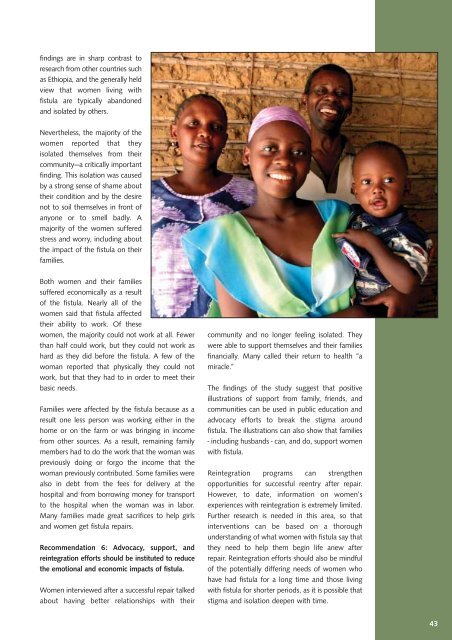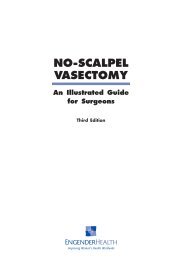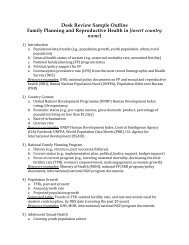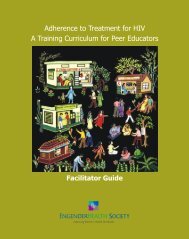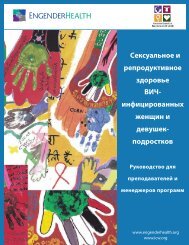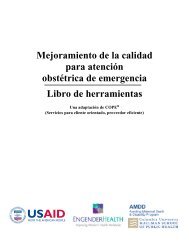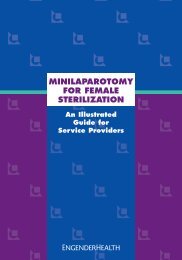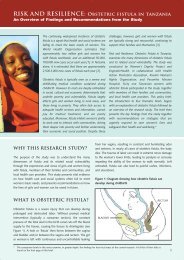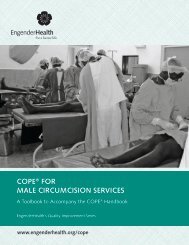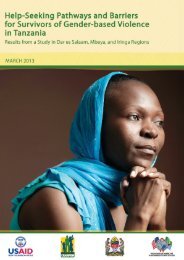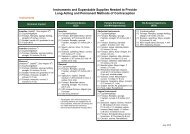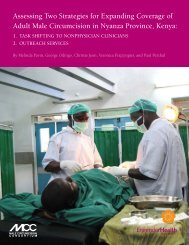Risk and Resilience: Obstetric Fistula in Tanzania - EngenderHealth
Risk and Resilience: Obstetric Fistula in Tanzania - EngenderHealth
Risk and Resilience: Obstetric Fistula in Tanzania - EngenderHealth
You also want an ePaper? Increase the reach of your titles
YUMPU automatically turns print PDFs into web optimized ePapers that Google loves.
f<strong>in</strong>d<strong>in</strong>gs are <strong>in</strong> sharp contrast to<br />
research from other countries such<br />
as Ethiopia, <strong>and</strong> the generally held<br />
view that women liv<strong>in</strong>g with<br />
fistula are typically ab<strong>and</strong>oned<br />
<strong>and</strong> isolated by others.<br />
Nevertheless, the majority of the<br />
women reported that they<br />
isolated themselves from their<br />
community—a critically important<br />
f<strong>in</strong>d<strong>in</strong>g. This isolation was caused<br />
by a strong sense of shame about<br />
their condition <strong>and</strong> by the desire<br />
not to soil themselves <strong>in</strong> front of<br />
anyone or to smell badly. A<br />
majority of the women suffered<br />
stress <strong>and</strong> worry, <strong>in</strong>clud<strong>in</strong>g about<br />
the impact of the fistula on their<br />
families.<br />
Both women <strong>and</strong> their families<br />
suffered economically as a result<br />
of the fistula. Nearly all of the<br />
women said that fistula affected<br />
their ability to work. Of these<br />
women, the majority could not work at all. Fewer<br />
than half could work, but they could not work as<br />
hard as they did before the fistula. A few of the<br />
woman reported that physically they could not<br />
work, but that they had to <strong>in</strong> order to meet their<br />
basic needs.<br />
Families were affected by the fistula because as a<br />
result one less person was work<strong>in</strong>g either <strong>in</strong> the<br />
home or on the farm or was br<strong>in</strong>g<strong>in</strong>g <strong>in</strong> <strong>in</strong>come<br />
from other sources. As a result, rema<strong>in</strong><strong>in</strong>g family<br />
members had to do the work that the woman was<br />
previously do<strong>in</strong>g or forgo the <strong>in</strong>come that the<br />
woman previously contributed. Some families were<br />
also <strong>in</strong> debt from the fees for delivery at the<br />
hospital <strong>and</strong> from borrow<strong>in</strong>g money for transport<br />
to the hospital when the woman was <strong>in</strong> labor.<br />
Many families made great sacrifices to help girls<br />
<strong>and</strong> women get fistula repairs.<br />
Recommendation 6: Advocacy, support, <strong>and</strong><br />
re<strong>in</strong>tegration efforts should be <strong>in</strong>stituted to reduce<br />
the emotional <strong>and</strong> economic impacts of fistula.<br />
Women <strong>in</strong>terviewed after a successful repair talked<br />
about hav<strong>in</strong>g better relationships with their<br />
community <strong>and</strong> no longer feel<strong>in</strong>g isolated. They<br />
were able to support themselves <strong>and</strong> their families<br />
f<strong>in</strong>ancially. Many called their return to health “a<br />
miracle.”<br />
The f<strong>in</strong>d<strong>in</strong>gs of the study suggest that positive<br />
illustrations of support from family, friends, <strong>and</strong><br />
communities can be used <strong>in</strong> public education <strong>and</strong><br />
advocacy efforts to break the stigma around<br />
fistula. The illustrations can also show that families<br />
- <strong>in</strong>clud<strong>in</strong>g husb<strong>and</strong>s - can, <strong>and</strong> do, support women<br />
with fistula.<br />
Re<strong>in</strong>tegration programs can strengthen<br />
opportunities for successful reentry after repair.<br />
However, to date, <strong>in</strong>formation on women’s<br />
experiences with re<strong>in</strong>tegration is extremely limited.<br />
Further research is needed <strong>in</strong> this area, so that<br />
<strong>in</strong>terventions can be based on a thorough<br />
underst<strong>and</strong><strong>in</strong>g of what women with fistula say that<br />
they need to help them beg<strong>in</strong> life anew after<br />
repair. Re<strong>in</strong>tegration efforts should also be m<strong>in</strong>dful<br />
of the potentially differ<strong>in</strong>g needs of women who<br />
have had fistula for a long time <strong>and</strong> those liv<strong>in</strong>g<br />
with fistula for shorter periods, as it is possible that<br />
stigma <strong>and</strong> isolation deepen with time.<br />
43


